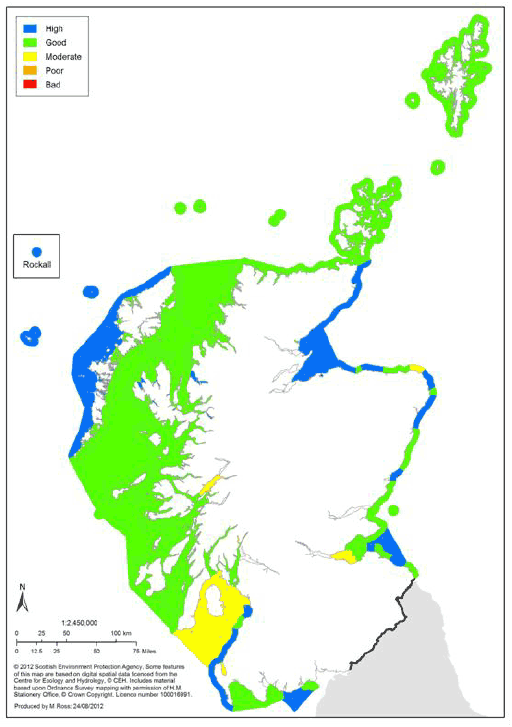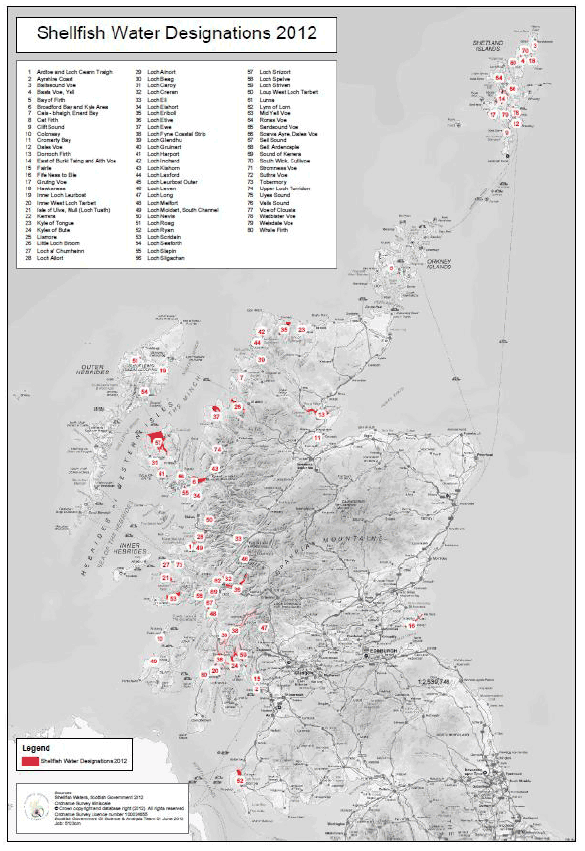Draft Sectoral Marine Plans for Offshore Renewable Energy in Scottish Waters - Environmental Report Appendix B: Baseline Information
Appendix B to the SEA Environmental Report of the Draft Sectoral Marine Plans for Offshore Renewable Energy in Scottish Waters.
This appendix contains Baseline Information.
1.4 Water
Key Issues Summary
- Contamination of the water environment as a result of marine activities such as the use of anti-fouling paint, pollution from oil spillage and sewage.
- Although coastal waters are generally of good or better status under the Water Framework Directive, poorer water quality is found in areas such as the Firth of Forth and Firth of Clyde.
- Pollution of coastal waters resulting from activities on land, in particular from agricultural activities.
- Polluted water impacts on habitats and species, tourism and aquaculture (particularly shellfish), all of which require high water quality.
- Coastal and marine litter impacts on biodiversity and other marine activities.
National Marine Baseline
1.4.1 Scotland's marine water resources support important industries including fishing, oil and gas industry and renewable power generation. In very simple terms the offshore and coastal water residual movement is northwards on the west coast (the Scottish Coastal Current) and southerly in the North Sea as a result of the inflow of mixed coastal and oceanic water of the Fair Isle Current [130] .
1.4.2 The tidal range varies around the Scottish coastline with a low tidal range at Shetland and off Kintyre and high tidal ranges at the heads of the Firths ( e.g. up to 7m in the Solway Firth). Tidal currents can be strong and intensified in localised areas, often where the flow is constrained by topography or in constricted bedrock channels ( e.g. between Orkney and Shetland, the Pentland Firth and off the Mull of Kintyre) [131] .
1.4.3 Benthic marine habitats include all biological communities associated with the sea floor, from the top of the intertidal zone and inner reaches of estuaries down to the deep sea. These habitats are considered under the topic of biodiversity.
Water Quality and Ecological Status
1.4.4 There are a number of mechanisms in place for monitoring and managing the quality of our waters:
- The Water Framework Directive ( WFD) establishes a framework for the protection of inland surface waters (rivers and lakes), transitional waters (estuaries), coastal waters and groundwater, with the aim of ensuring all aquatic ecosystems meet 'good status' by 2015 [132] ;
- River Basin Management Plans ( RBMP) have been prepared for the Scotland and Solway-Tweed River Basin Districts ( RBD) to address the requirements of the Directive in relation to the management of Scotland's river systems. Both plans also provide an overview of the state of the water environment for their districts [133] . SEPA are now in the process of developing the second RBMPs for completion in 2015.
1.4.5 Scotland's coastal and transitional waters (see Figure B1.4.1) are monitored by SEPA to measure performance and compliance with targets for coastal water quality status under the WFD. In all, 63% of Scotland's water bodies were at good or better status in 2010. Of these, some 96% of coastal waters, 86% of estuaries and 54% of sea lochs and freshwater lochs were classed as in 'good' or 'better' condition in 2010 [134] .
1.4.6 While 96% of coastal waters in Scotland were classified as excellent or good condition, some 95% were reported as having achieved an improvement in condition [135] . However, some coastal water bodies and a particularly high proportion of transitional waterbodies [136] (76%) remain at risk of not meeting the objectives of the WFD by 2015.
Figure B1.4.1: Coastal and Transitional Waters Classification 2011 [137]

Shellfish Waters
1.4.7 In 2012, some 80 coastal water areas in Scotland have been designated "shellfish growing waters" under the EU Shellfish Waters Directive (2006/113/ EEC)[138] (see Figure B1.4.2). These areas are predominantly located on the west coast of the Scottish mainland and the Northern and Western Isles [139] . In 2010, water quality monitoring undertaken by SEPA indicated that all designated sites ( i.e. all 78 sites that were designated as "shellfish growing waters" in 2009) met the minimum environmental quality standards (the 'mandatory' standard) set by the Directive, although just 69% of shellfish waters were found to have achieved the more stringent guideline quality standard (the 'guideline' standard) [140] . While most designated sites met the stricter guideline values for physical and chemical parameters, exceedances of the stricter bacteriological guideline value were recorded at over a quarter of these sites [141] .
Potential Contamination Sources
1.4.8 Potential sources of pollution of the water environment and the pollutants entering the water environment can be varied, with most likely to be localised and site specific. These can include shipping and boating ( e.g. the use of anti-fouling tributyltin and copper paints [142] , and other synthetic substances [143] ); oil discharges from incidents, collisions or the release of ballast water [144] ; introduced non-native species from ballast or vessel hulls [145] ; discrete and diffuse terrestrial sources ( e.g. natural weathering, industrial discharges and agriculture [146] ), atmospheric sources ( e.g. chemical contaminants and dust [147] ); marine and beach litter including public litter, sewage related debris, fishing and shipping litter [148] ; radioactive contamination ( e.g. naturally occurring radioactive material ( NORM), wastes [149] and accidental releases [150] ); and munitions contamination and military waste [151] .
1.4.9 The effects of climate change have the potential to exacerbate impacts from other sources by reducing the ability of the water environment to safely absorb and break down pollution. The likelihood of reduced summer rainfall may mean less water is available in rivers and inland waters for diluting pollutants during these periods [152] . Conversely, expected higher annual river flows, particularly during winter months, may help dilute pollutant discharges to rivers while increasing the quantity of pollutants reaching coastal and marine waters.
Figure B1.4.2: Location of Shellfish Waters Within Scotland 2012 [153]

Bathing Waters
1.4.10 Bathing waters are classed as protected areas under Annex IV of the WFD due to their sensitivity to pollution or their economic, social and environmental importance. The EC Bathing Water Directive (2006/7/ EC), translated into Scottish law by the Bathing Waters (Scotland) Regulations 2008, aims to preserve, protect and improve the quality of the environment and to protect human health. It sets out two quality standards, the 'mandatory' and the stricter 'guideline' standard, stating that member states should comply with the mandatory standard and aim to comply with the guideline standard. The majority of monitored and sampled sites are located on the east, north-east and south-west coasts, with isolated sites on the north and west coasts, and no sampling sites located in the Northern or Western Isles.
1.4.11 Scotland's bathing waters comprise 80 coastal and 3 inland waters, and their quality has steadily improved over recent years. In 2011, 95% of Scotland's bathing waters achieved the 'mandatory' standard for bathing water quality, and of these, nearly half also met the more stringent 'guideline' standard. Just four waters (Sandyhills, Irvine, Lossiemouth East and Eyemouth) failed to achieve mandatory quality compliance [154] . The 2011 monitoring report indicates that pollutants ( i.e. bacteria and diffuse pollutants) from agricultural or urban runoff mobilised from heavy rainfall are the most likely causes of these exceedances.
Contact
There is a problem
Thanks for your feedback